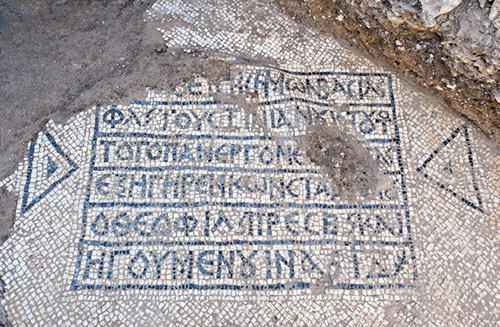
(TPS) Archaeologists announced Wednesday that they have unearthed a Greek inscription mentioning the Byzantine emperor Justinian on a mosaic floor near Damascus Gate, in the Old City of Jerusalem.
The 1,500-year-old mosaic was discovered earlier this summer following groundwork to lay cable infrastructure in the area. Given the proximity to Damascus Gate, historically the main entrance to Jerusalem from the north, archaeologists said the floor was probably used as a hostel for pilgrims.
“The Damascus Gate served for hundreds of years as the main northern entrance to Jerusalem. Knowing that, it is no surprise that this area is rich with archaeological remains. In the Byzantine period, with the emergence of Christianity, churches, monasteries and hostels for pilgrims were built in the area north of the gate, and the area became one of the most important and active areas of the city, said David Gellman, who directed the excavation on behalf of the Israel Antiquities Authority.
Gellman added that although ancient artifacts are common in the area, the new discovery is significant because it is almost completely intact.
“The fact that the inscription survived is an archaeological miracle,” he said. “The excavation in a relatively small area exposed ancient remains that were severely damaged by infrastructure groundwork over the last few decades. We were about to close the excavation when, all of a sudden, a corner of the mosaic inscription peeked out between the pipes and cables. Amazingly, it had not been damaged.
“Every archaeologist dreams of finding an inscription in their excavations, especially one so well preserved and almost entirely intact,” Gellman concluded.
According to Dr. Leah Di Segni, an expert on ancient Greek at the Hebrew University of Jerusalem who deciphered the inscription, the text mentions the Byzantine emperor Flavius Justinian as well as the well-known priest Constantine. She said the inscription reads, “In the time of our most pious emperor Flavius Justinian, also this entire building Constantine, the most God-loving priest and abbot, established and raised, in the 14th indiction.”
“Indiction” is an ancient method of counting years for taxation purposes, Di Segni said. Based on historical sources, she added that the mosaic can be dated to the year 550/551 CE.
The two people mentioned in the inscription, Justinian and Constantine, are well known from both ancient historical sources and archaeological finds. The IAA said in a release that the emperor Flavius Justinian ruled the Roman empire at its height and oversaw its conversion to Christianity, eventually building a large church dedicated to the Virgin Mary.
The structure, built in the year 543 CE and known as the Nea Church, was the largest church built in Jerusalem and one of the largest in the entire empire. The abbot of the church was Constantine, whose name appears in the inscription revealed Wednesday. Remains of the Nea Church were partially unearthed in 1970 during a rash of excavations in the Old City following the Six-Day War three years earlier
“This new inscription helps us understand Justinian’s building projects in Jerusalem, especially the Nea Church. The rare combination of archaeological finds and historical sources woven together is incredible to witness, and they throw important light on Jerusalem’s past, Di Segni added.
IAA officials said the inscription was removed from its site by conservation experts and is being treated in the IAA’s mosaic workshop in Jerusalem.










